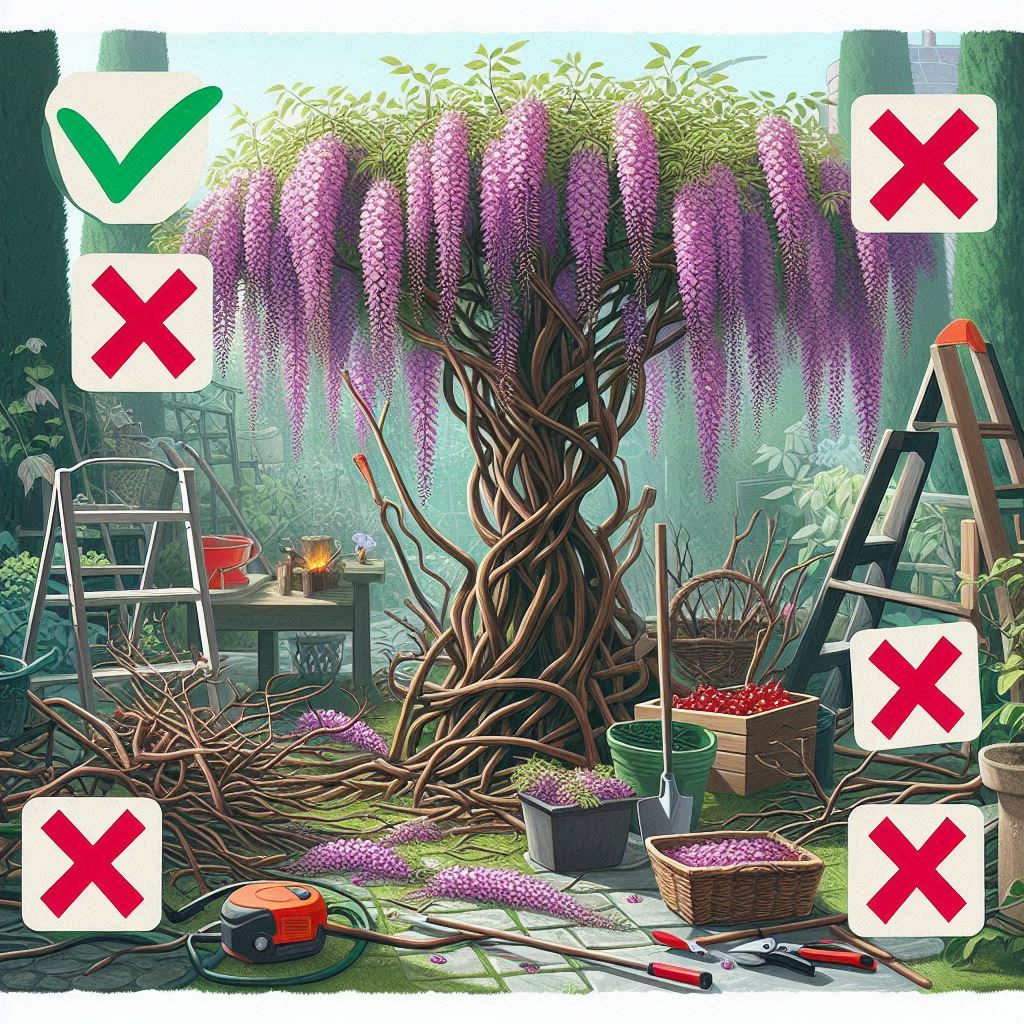How to Prune Wisteria in 2025: The Complete Guide for Vigorous Blooms and Tangle-Free Vines

For gardeners, wisteria—wild, winding, and wonderful—can be both a dream and a nightmare! 🌸 It’s no secret that if left unchecked, this rapidly spreading vine can quickly take over. The good news is that if you know how to prune wisteria you can make it a stunning garden focal point by using the proper pruning techniques. The Royal Horticultural Society claims that appropriate pruning significantly lengthens flowering seasons and doubles bloom production.
This comprehensive guide on how to prune wisteria will assist you in making deliberate and accurate pruning decisions, regardless of whether you’re working with a brand-new vine or an old, tangled mess. Are you ready to bring out the blooms and tame the beast? Let’s begin!
The Significance of Knowing How to Prune Wisteria

Wisteria is infamous for its invasiveness and quick growth. It can suffocate surrounding plants, pergolas, and trellises if it isn’t regularly pruned. Mastering how to prune wisteria promotes prompt pruning which will enhance abundant flowering and aids in managing this hardy climber.
Additionally, routine maintenance:
- Reduces fungal disease by improving airflow
- Improves the vine’s appearance by shaping it
- Prevents excessive weight from causing structural damage
- Increases the lifespan of the plant
In addition to limiting the vine’s growth, how to prune wisteria refocuses its energy on producing blooms, which is what most gardeners want to achieve.
Equipment You’ll Need Before You Begin

Get the following supplies before beginning to prune wisteria:
- For accurate cuts on young shoots, avoid using pruners
- Loppers for runners and stems that are thicker
- Pruning saw for woody or aged trunks
- Gloves to keep your hands safe
- Tool sanitization with a disinfectant (such as bleach solution or rubbing alcohol)
- Safety equipment for tall vines, such as a ladder, goggles, or a helmet
To prevent plant stress and disease, make sure your tools are clean and sharp before using them.
When to Prune Wisteria: Time Is of the Essence!

You should prune wisteria at two main times:
- Summer (July/August): Light pruning to promote bud formation and regulate new growth.
- Winter (January–February): Vigorous pruning to enhance spring blooming and shape the vine.
Trimming shoots back to five or six leaves is known as light pruning. Winter pruning, on the other hand, reduces those same shoots to two or three buds.
Regional Tip: To prevent frost damage, colder regions should wait until late winter, while warmer zones may prune a little earlier.
Step-by-Step Guide on How to Prune Wisteria

Step 1: Determine the Principal Structural Vines
These are the woody stems that form the framework of the vine. Don’t cut them. Instead, remove any stray shoots that don’t add to the main structure using your gloves and bypass pruners.
Step 2: Reduce the Shoots of the Current Year (Summer Pruning)
Cut the green, whippy shoots down to five or six leaves with your bypass pruners. By doing this, the plant is better able to concentrate on developing flower buds rather than new leaves.
Step 3: Winter Pruning (Recut to 2–3 Buds)
Go back to those same shoots in the winter. Using bypass pruners once more, cut them back to two or three buds. This focuses energy on a smaller number of stronger stems that produce flowers.
Step 4: Get Rid of Thick Stems, Runners, and Unwanted Suckers
Depending on their thickness, runners crawling outward and suckers at the base can be clipped with a pruning saw or loppers. Never be afraid to trim off overly active shoots that detract from the main form of the vine.
Step 5: Teach Vines to Take on the Shape You Want
Use soft ties to guide your vine along a pergola, arch, or trellis. To keep a beautiful and controllable shape, gently tie young shoots to support structures.
Step 6: Clean the Instruments After Cutting
Clean your saws, loppers, and bypass pruners after each few cuts to stop the spread of disease. Your plant can avoid serious problems with a quick dip in disinfectant.
Bonus Tip: Don’t freak out if you’re dealing with an overgrown vine. Pruning should usually be done gradually over two seasons.
We also have guides on how to prune fig trees and citrus trees
How to Prune Wisteria that is Old or Neglected
If your wisteria hasn’t had any pruning done in years, begin by removing everything except the old framework. Carefully trim twisted stems and thick trunks with a pruning saw.
Take your time so as not to startle the plant. Blooming may be postponed for a season if too much is removed at once. Instead, remove dead wood and maintain shape by phasing out hard pruning over a few years.
Typical Errors on How to Prune Wisteria to Avoid

Even experienced gardeners make mistakes. Steer clear of these pitfalls:
- Pruning too much can significantly lower bloom production.
- Bud formation is impacted by improper pruning timing.
- Trellises and pergolas may sustain damage if structural balance is neglected.
- Rather than cutting non-flowering shoots, cut flowering ones.
- Using unclean or boring tools stresses plants and encourages disease.
How to Prune Wisteria to Promote More Blooms
Are you curious about knowing how to prune wisteria to make it bloom profusely?
- To promote the formation of flower buds, trim back summer growth.
- In order to concentrate energy in fewer buds, cut the shoots once more in the winter.
- To promote more flowering, train vines horizontally along a wall or trellis.
- Use a fertilizer high in phosphorus to encourage the growth of blooms.
To control overly active vines, some gardeners also apply mild growth inhibitors or use organic bloom boosters.
How to Prune Wisteria in Various Climates
To ensure robust growth and colorful blooms, it’s important to understand how to prune wisteria in various climates. In colder climates, major pruning should wait until late winter. This prevents frost damage to young shoots that might otherwise be harmed.
How to prune wisteria involves more frequency in warmer climates, particularly in the summer when growth is more rapid. To promote flowering instead of foliage, trim long, straggling shoots back to five or six buds. Appropriate airflow is crucial in humid or tropical climates.
Remove overcrowded shoots to reveal the interior structure of the plant. Your wisteria will flourish throughout the year if you adjust your pruning schedule to your climate.
How to Prune Wisteria from Walls, Fences, and Pergolas
How to prune wisteria depends on where you grow it. Trim the long tendrils that hang down if it climbs over a pergola. These can become messy and are prone to tangles. To keep things tidy, trim them back to about 6 inches.
Use horizontal lines to direct growth on fences. This keeps one side from getting overly dense and promotes uniform blooming. In winter, trim side shoots to two or three buds.
There is less room when wisteria climbs a wall. Train branches carefully and prune close to the structure. Maintaining both structure and beauty requires knowing how to prune wisteria based on its support.
How to Prune Wisteria for the First Time
Learning how to prune wisteria can be scary if you’ve never done it before, but doing it correctly now will result in years of beautiful blooms. Start by removing weaker side shoots from a strong central stem. This creates a strong main trunk.
Trim long, immature shoots during the first summer to help shape the plant. Then trim side shoots to roughly three buds in the winter. This process creates a robust framework and encourages flowering.
Don’t prune too much at first. The vine is meant to be trained, not stressed. Learning how to prune wisteria early on will guarantee that it develops into a robust, blooming plant that is simple to care for in the future.
How to Prune Wisteria in Pots or Containers
For wisteria to remain compact and produce quality flowers, it requires frequent, meticulous pruning when grown in pots or containers. Control is crucial because of the limited space. To avoid overgrowth and maintain the plant’s shape in the summer, trim new shoots to about 6 inches.
Winter is the season for accuracy. Reduce each side shoot to two or three buds. This maintains the focus on flower production rather than foliage. To restore the plant’s vitality, prune its roots every few years.
To direct the vines, use a small trellis or other support. Wisteria in pots can remain lovely in small areas and avoid becoming unmanageable if you know how to prune it.
How to Prune Wisteria Without Causing Damage
Many gardeners worry about harming their plant, but learning how to prune wisteria without causing damage is mostly about timing and technique. Knowing how to prune wisteria when buds are forming in the early spring can lessen your flowering display.
For smooth cuts, always use sharp, clean tools. To encourage healing and regrowth, cut slightly above a healthy bud or joint. Removing too much foliage at once could shock the plant.
Space out your pruning sessions instead. Winter pruning promotes blooms, while light summer trimming maintains shape. Your wisteria will remain healthy and flourish if you prune it carefully and gradually.
How to Prune Wisteria to Promote Shape and Beauty
In addition to being healthy and producing flowers, wisteria shape enhances the aesthetics of your garden. The way wisteria is pruned greatly affects whether you want a tidy tree shape or graceful vines over an arch. Choose whether you want a formal or wild and natural look first.
After that, use summer pruning to eliminate stray shoots and regulate direction. Young stems should be tied to supports such as trellises or wires. Cut side shoots shorter in the winter to highlight structure and symmetry.
This method of how to prune wisteria increases bloom coverage in addition to appearance. You can make your wisteria a true focal point of your garden by pruning it with shape in mind.
After Pruning, How to Train Wisteria
Following applying the right technique of how to prune wisteria, it should be properly trained to keep its shape and promote flowering. Choose sturdy shoots that are positioned correctly to serve as the plant’s main framework first. Soft garden ties can be used to gently secure these stems to supports like pergolas, trellises, or wires.
To avoid girdling or damage during the growing season, check and adjust ties frequently. To keep the plant neat and concentrated on blooming, trim off any shoots that are growing in undesirable directions.
Early training of young vines guarantees a visually appealing, well-structured plant and lessens the need for extensive pruning later. Every year, your wisteria will continue to bloom abundantly and look its best with regular training and pruning.
How to Prune Wisteria to Promote Seed Production and Fruiting
Wisteria is typically pruned to encourage flowers, but if you master how to prune wisteria carefully, you can also encourage fruiting and seed pods. Steer clear of heavy pruning after the main blooming period so that seed pods can grow naturally.
To preserve plant health without interfering with seed formation, only trim damaged or excessively long shoots. Fruiting wisteria can be messy if not controlled, but its hanging seed pods add visual interest.
Allow the pods to fully mature before harvesting if you wish to gather seeds for propagation. You can get both amazing blooms and seed production by coordinating pruning with the plant’s natural fruiting cycle only if you know how to prune wisteria properly.
How to Prune Wisteria to Maintain Structural Integrity and Safety
If unchecked, wisteria vines can grow heavy and possibly cause damage to buildings. This can be avoided by pruning with safety in mind. Remove tangled or excessively thick growth on a regular basis to avoid straining walls, fences, or pergolas.
Check for damage from heavy vines on the supports and reinforce them as necessary. Trim any overgrown or dangerously oriented shoots, especially those that are close to doors or walkways.
Knowing how to prune wisteria helps to keep your plant balanced and properly pruned, you can lower the chance of broken branches or structural failure, keeping your plant and garden safe and attractive.
How to Prune Wisteria for Indoor Growth
Knowing how to prune wisteria carefully is necessary when growing it indoors in order to control size and promote flowering in a small area. Throughout the growing season, trim new shoots frequently to keep the plant compact and prevent it from outgrowing its pot or support.
To concentrate energy on producing blooms, trim side shoots back to two or three buds in the winter. To train the vines, provide a strong indoor trellis or frame.
Because indoor and outdoor climates differ, keep a careful eye on light and humidity levels and make necessary pruning adjustments. Your wisteria will flourish and bloom exquisitely inside your house if you prune it carefully indoors.
How to Take Care of Wisteria After Pruning
Your wisteria deserves some care following a successful pruning session:
- In dry weather, water deeply to alleviate stress.
- Use a fertilizer containing phosphorus to encourage the growth of flowers.
- Keep an eye out for symptoms of shock, such as wilting or yellowing leaves.
- As new shoots grow, tie them to arbors or trellises for support.
Maintaining the health of your vine and identifying any problems early are made possible by routine observation.
In conclusion
How to prune wisteria may seem difficult, but it’s your best friend when it comes to beautiful blooms and garden management. 🌿 You can enjoy colorful cascades of purple (or white!) flowers year after year if you learn the rhythm of the vine and use the proper tools to make strategic cuts. Thus, get your pruning tools, make a note of the date for your garden, and provide your wisteria with the professional attention it requires. Your entire garden or pergola will appreciate it.
